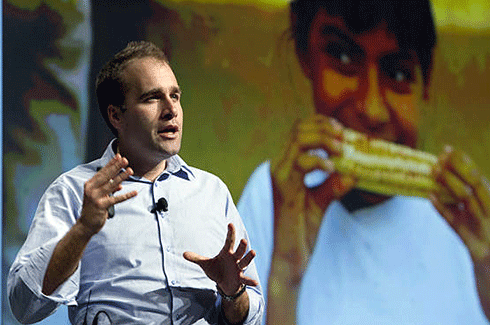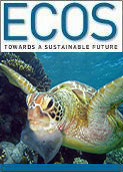
|
Published: 19 August 2013
Stefan Hajkowicz: on megatrends and ‘freefall’ moments
It is Stefan Hajkowicz’s job to think big. At CSIRO Futures, his focus is global and long term. The six ‘megatrends’ that Dr Hajkowicz identified in a 2009 report Our Future World: Global megatrends that will change the way we live seem to have struck a chord with many Australians. As a result, he has found himself in demand as a speaker and consultant for industry and government.
Dr Hajkowicz currently leads the CSIRO Futures team in its mission to provide evidence-based forecasting that government and industry can use in making long-term and large-scale investment and planning choices. He is in conversation here with Michele Sabto.
Why do you think that the concept of megatrends has struck such a chord?1
It is often hard for policy makers and business people to think decades into the future but it is necessary given the challenges we face as a society. The megatrends combine science, evidence and data, with a creative narrative about the future in an appealing package that helps stimulate long-term thinking.
As an example, Wesfarmers, a company with over 200 000 employees had a meeting of their executive in Melbourne recently, involving around 400 staff. They used the megatrends report in a strategy session to think about change in their organisation.
One of the megatrends identified in the report is ‘more from less’. Is there more to this issue than energy efficiency, water use efficiency, and mindful consumption?
My view is that the resource scarcity dilemma is an interesting one. Let’s look at food security. The first conclusion often drawn from the statistics is there isn’t enough food in the world. In other words, it’s a food production challenge.
But when you delve deeper, you find that 35 per cent of the food that is made in this world is never eaten. It’s wasted. And that already solves the food problem.
We also have 1 billion people in the world who are overfed and suffer malnutrition because they eat too much food, while at the same time we have one billion people who are underfed and suffer from not enough food, a bitter irony. In parts of the developing world such as Africa the problems are often those of governance, corruption, and markets not working properly. That’s why we have food shortages.
I think humans have adequate natural resources to meet all our needs. [The real barrier] for us [is how] to share, manage and wisely use those resources. But that kind of dilemma is always going to be with us, so the ‘more from less’ megatrend still applies because efficiency is important.
In the ‘silk highway’ trend, you touch on the fact that among the populations of fast-developing Asian economies, there is increasing demand for resource-intensive lifestyles. Doesn’t that impact on the gains that might be made from energy efficiency improvements?
Over the coming decades, one billion people in Asia will transition out of poverty and into the middle income bracket of between US$6000 and US$30 000 per year. Global demand for high protein foods, tourism services and consumer durables has risen sharply over the last decade.
On the other hand, technology opens up a lot of avenues to make more efficient use of the resources we have. Over time, a wealthy economy will decrease its energy intensity (where energy intensity means the amount of energy required to produce one dollar of GDP). That’s because we start, for example, using more energy-efficient light-bulbs, which gives us the same amount of light but lower overall energy consumption and overall costs.
Received wisdom is that this trend goes the other direction in developing countries; in fact, developing countries can leap-frog a lot of the development that wealthier countries have gone through by putting in place new technology. As an example, in parts of Africa, mobile communication has become far more widespread than landlines have ever been.
How would you like to see Australian policy makers and business people use the megatrends report?
I would like to see this report prompt conversation and thinking about issues. I’m a big believer that, in relation to the hard-to-solve problems, if society thinks, talks and holds informed conversations about them, the solutions gradually start to emerge over time.
Australia is in a really challenging space at the moment economically. We’ve seen commodity prices – coal, iron-ore and gold – drop to 40 per cent of what they were, with implications for the economy.
The rate of development and advancement in the Asian region is phenomenal – and they are jumping into a space we occupy.
I think we have an innovation imperative in Australia that these megatrends highlight: [to embrace] hard-to-fix problems and the opportunities associated with them, with no clear solution other than getting really smart about how we do things. One of our challenges is to develop some leadership so we can take advantage of these [opportunities] in Australia.
Where does this megatrends work go next?
My next big task is writing a book on the megatrends, Moments of Freefall. It will argue that there are critical periods in history where current systems go into free fall and societies are thrown into a radical new environments that create big opportunities but big challenges at the same time, and that these moments result from megatrends.
The book will look at moments of freefall that have happened in the past and will explore the megatrends to identify which of them may occur in the future, with an Australian focus.
|
The megatrends report has played a pivotal role in the early stages of The Queensland Plan, a 30-year vision for the state that is being developed through a grassroots engagement process, with Queenslanders being given the opportunity to contribute at each step. The process kicked off with a summit held in Mackay in May 2013, where over 400 delegates were asked to come up with questions for Queenslanders to answer during the engagement phase ending August 2013. |
‘Everyone at the Mackay summit was given the megatrends in advance, Stefan did a brief presentation on what they were, and people used them as the basis for developing questions,’ says Sue Rickerby, Deputy Director-General of Priority Projects at the Queensland Department of the Premier and Cabinet. |
‘We have the questions online in a survey form and we’re asking people to have a look at the megatrends before they answer the questions. The megatrends have given people a context in which to frame their responses in thinking ahead 30 years.’ |
After all the responses to the questions developed at the Mackay summit are in – more than 30 000 people have already responded – the next job will be to synthesise them for a summit being held in Brisbane in October 2013. At the summit, attendees will consider what Queenslanders have said in the context of the megatrends and what that means for the 30-year vision. |
1 In this context, a trend refers to a pattern of social environmental and economic activity that will play out into the future, while a megatrend occurs at the intersection of many trends and will play out over the coming decades.




